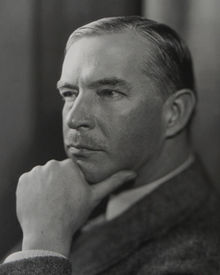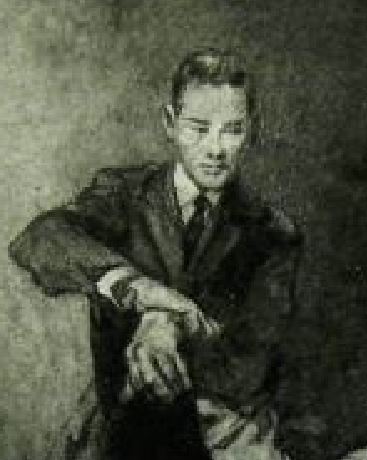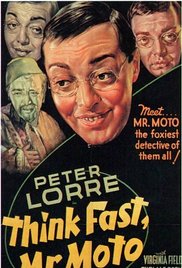What Pulitzer Prize winning author of satirical novels also created one of the most memorable spy detectives in both books and films? The answer is−John P. Marquand.
John P. Marquand won the Pulitzer Prize for The Late George Apley (1938). His title character, George Apley, is a Harvard-educated, white, Anglo-Saxon protestant living on Beacon Hill in downtown Boston. Beacon Hill is one of the oldest and wealthiest areas of Boston where the old money families live. It is located near the Massachusetts State House which sits prominently at the top of the hill, which gives us the term “Beacon Hill.” It was this world of wealth, privilege and power with its strict code for social behavior that Marquand was born into and later satirized.
Marquand’s Early Years
Marquand was descendant from several of the early governors of the Massachusetts Bay Colony. His mother was the great niece of well-known feminist writer, Margaret Fuller, and a cousin of Buckminster Fuller. Aside from his prestige lineage, there was the family fortune made from shipping and merchandising.
However, during the crash of 1907 the family lost their money and suffered a financial downturn. Marquand was sent to live with two eccentric aunts in an old deteriorating mansion in Newburyport, Massachusetts. Unable to afford the tuition for an elite private school he attended the local public high school. He did go to Harvard by winning a scholarship for Chemistry.
At Harvard, he had wanted to write for the newspaper but was turned down. Instead he was elected to the editorial board of the humor magazine, the Harvard Lampoon. After graduation, he finally worked for a newspaper when he was hired by the Boston Evening Transcript in 1915.
In 1922 he married Christina Sedgwick, niece of The Atlantic Monthly editor, Ellery Sedgwick. In 1925 Marquand published, Lord Timothy Dexter. This was considered an important book about the life of this Newburyport eccentric. His other well-known satirical novels include H. M. Pulham, Esquire (1941), B.F.’s Daughter (1946) and Sincerely, Willis Wade (1955).
By the mid-1930’s he was a prolific and successful writer and a regular contributor of fiction for slick magazines like The Saturday Evening Post. By the late 1930’s, Marquand, had created a series of novels about life in the upper-class.
Although he had been snubbed by his college roommates for his lack of wealth, he ultimately joined and embodied the lifestyle of the upper-class including owning luxury homes in Newburyport and the Caribbean. He was part of the very social scene that he often portrayed in a negative light. He was even linked to the Rockefeller family through his second wife, Adelaide Ferry Hooker, whose sister, Blanchette, was married to John D. Rockefeller III.
However, since this is a mystery blog, we think Marquand’s most important work was the creation of Japanese master spy and detective, Mr. Moto. Marquand achieved great popularity and commercial success with his spy novels about this fictional detective.
The Creation of Mr. Moto
Marquand was asked by The Saturday Evening Post to write a series of stories featuring an Asian character. In fact, the magazine sent him on a trip to Asia to do research. The magazine was attempting to fill the void created by the death of Erle Derr Biggers, the creator of Charlie Chan.
His first Moto story appeared in the magazine under the title, No Hero but later when published as a novel it was changed to, Your Turn, Mr. Moto.
Marquand wrote six Moto novels between 1935 and 1957. All six novels were serialized first as magazine stories in The Saturday Evening Post except for Last Laugh, Mr. Moto which was serialized in Collier’s Weekly.
Marquand’s Moto novels were adapted into 23 radio shows starring James Monk. The first radio show was called A Force Called X07 (May,1951) and ended with The Dry Martini (October, 1951). Eight motion pictures were developed by Twentieth Century Fox starring Peter Lorre and Henry Silva starred in a 1965 film, The Return of Mr. Moto. In 2003 Moonstone Books published a graphic novel called Welcome Back, Mr. Moto.
Who Is Mr. Moto
When Mr. I.A. Moto is introduced to us, he appears as an eccentric Japanese aristocrat. In Think fast, Mr. Moto, Moto is described as a small man, delicate, almost fragile. 
He was dressed formally in morning coat and striped trousers. His black hair was carefully brushed in the Prussian style. He was smiling, showing a row of shiny gold-filled teeth, and as he smiled he drew in his breath with a polite, soft sibilant sound.
The focus of the novels is on westerners who experience problems involving some international intrigue. They are written from the westerner’s point of view. Mr. Moto is an international spy that operates behind the scene and enters into their lives to help them find a solution to their problem and extract them from danger.
In Think Fast, Mr. Moto he mentions other skills that he possesses:
Yes, I can do many things. I can mix drinks and wait on tables, and I am a very good valet. I can navigate and manage small boats. I have studied at two foreign universities. I also know carpentry and surveying and five Chinese dialects. So very many things come in useful.
Later in Mr. Moto Is So Sorry, we learn that one of the foreign universities he attended is American where he was a student of Anthropology. Later in the film versions of Mr. Moto, we will discover he has added several more skills to his list.
Plots of the Novels
In all the novels, Moto is a shadowy figure that seems to have numerous contacts in the Orient underworld that he manipulates to achieve his desired results. Let’s take a look at the first Mr. Moto book.
In Your Turn, Mr. Moto, Flying Ace Lee Casey finds himself stranded in Tokyo when his transpacific pilot job for a tobacco company is cancelled. Low on funds Casey accepts a lucrative job offer from Mr. Moto and finds himself on a ship bound for Shanghai. His fellow passenger and female lead in this story is Sonya, a White Russian, who also seems to be assisting Mr. Moto. When a Chinese man turns up dead in Casey’s cabin, the trio is caught in a game of danger that could affect all of their countries. 
In the final novel, The Last of Mr. Moto (Stopover Tokyo-magazine title) is set in the 1950’s. Mr. Moto is now an intelligent officer for the pro-western Japanese government.
Jack Rhyce, a former paratrooper from World War II, has changed careers to becomes a secret agent in the early years of the Cold War. Rhyce and fellow spy Ruth Bogart have been dispatched to Tokyo to foil an assassination attempt. However, while the team is working to stop a murder they must also deal with an additional problem. Japan is now forming close ties with America and a communist ring is stirring up anti-American sentiment.
Jack and Ruth are pretending to be representatives of the Asia Friendship League and are met by Mr. Moto at the airport. Mr. Moto is undercover as a would-be tour guide who offers to make their stay more pleasant.
The American spies immediately suspect that there’s more to Mr. Moto than what appears. They need to stop the sinister plot and discover if the mysterious Mr. Moto will be their ally, or their enemy.
Both of these examples are representative of the plots in the novels. A westerner is in peril in the world of spies and deadly plots. The constant danger is offset with a romance between the male hero and the female lead.
The characters may not always understand the motives of Mr. Moto but he is ultimately there to help them. There’s also a sense that the people he is helping are talented individuals who emerge as a new form of hero. Moto recognizes this when he says:
“Undercover work is always like that,” …the people one encounters are much the same. They may be shady and raffish, but don’t forget they’re all of them brave. They do their work like a piece on a chess board and nothing stops them from moving along the diagonal. … they’re working for their respective countries and that’s more than a lot of people do.”
Mr. Moto Films
During one of the winter months this year, there was a very snowy day. This is the kind of day where you don’t want to leave the house and curling up with a good book is the perfect solution.
On this day, instead of opting for a good mystery book, I decided to do my own film fest. I had just received the collection of Mr. Moto movies. These are the eight movies from 20th Century Fox filmed between 1937 and 1939 featuring Peter Lorrie. I started with the first film, Think Fast, Mr. Moto. 
Unlike the novels, there are several differences with the Mr. Moto in the films. Mr. I.A. Moto of the novels now has the first name of Kentaro. Mr. Moto is no longer the shadowy figure behind the scenes, but the focus of the films with the westerner playing a subordinate role. Occasionally he may be the seen in a tuxedo, but he does not wear formal morning attire as his normal dress and there is no signs of a gold tooth.
And perhaps based on the athleticism of Lorre we are aware that Moto is both an expert in Jiu-Jitsu and Judo and capable of circus like feats. He is a master of disguises and is also a skilled magician. For his personal enjoyment, he composes a form of poetry known as Haiku and draws caricatures.
The film plots are loosely based on the original stories but always involve spies and expose Mr. Moto to danger from some foreign government or group. And there is still the westerner who needs help in saving the secret plans, protecting their country or finding the hidden treasure. With the help of Mr. Moto, the problem is solved and for just a little while life returns to normal, until the next Moto film.
Mr. Moto Continues to be a Good Story
Mr. Moto was a good solid replacement for the Charlie Chan stories. I recommend on snowy days or on any day for that matter, to treat yourself to the detective stories of John P. Marquand’s, Mr. Moto. They are full of intrigue, spies, romance and plots that keeps the reader entertained.
